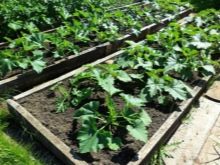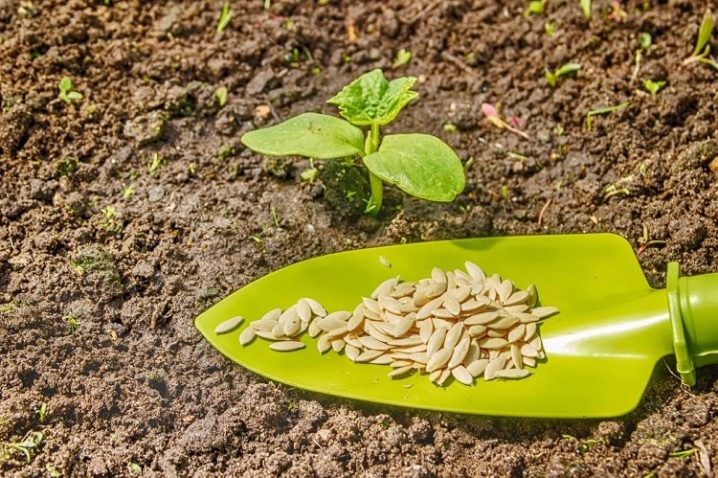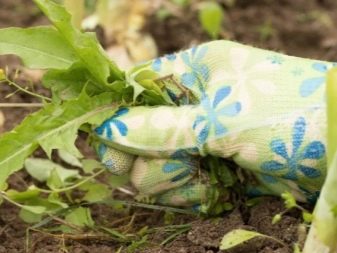Growing zucchini in the open field

Growing a rich harvest of zucchini in the open field in the country is the dream of any vegetable grower. In the material of this article, we will consider all the nuances, the knowledge of which will help to increase yields.


Variety selection
To grow a lot of vegetables, you need to choose the right seed material. There are a lot of varieties, but not all of them are suitable for a specific region, growing conditions. In addition, they differ in taste, shape, color, thickness of the skin. In terms of ripening, they are early, medium, late ripening. You need to choose for planting bush, self-pollinated, early-maturing varieties with powerful shoots that independently form bushes. They have a higher resistance to diseases, negative weather conditions.
There are several of the best varieties.
- "Gribovsky", frost-resistant, unpretentious in care. Fruiting in 55 days from the moment the seeds are planted.
- "Chaklun" high-yielding, with tender pulp. Harvested in 45 days, the fruits are smooth, white.
- "Zolotinka" - a variety with female flowering and yellow color. Abundantly fruiting, with excellent fruit taste.
- "Odessa bush" - an early ripe variety, bearing fruit on the 40th day from the time of planting the seeds. White, delicate, sweetish in taste.
- "Pharaoh" - unpretentious variety with dark green fruit. Suitable for cultivation in all regions of the country.
- "Pantheon" - one of the best varieties with a presentation. Demanding to a stable level of moisture and soil fertility.
Among other varieties suitable for planting in open ground, it is worth noting "Kavili F1", "Iskander F1", "Ardendo 174 F1", "Aral F1", "Tsukesha".



Sowing dates
The selected seed is sown in the warm soil in May. Optimum temperature indicators are from +20 to +26 degrees. The soil should be warmed up to +12 +15 degrees. Seeds planted under these conditions will germinate in 3-5 days. Varieties for winter storage are planted in open ground on June 1-5. However, the sowing time depends on the region.
- In the south of our country (in the Krasnodar Territory, Stavropol Territory, Crimea), the seed is planted in early - mid-May.
- In central Russia (Volga region, Moscow region), planting occurs in the middle - end of May.
- In the north and northwest (Urals, Siberia), the optimal planting time is late May - early June.
Of the members of the Pumpkin family, squash is considered the most cold-resistant crop. In some regions of the country, they can withstand night temperatures up to +8 +6 degrees.
However, if it is cooler at night, they will not withstand a larger (even short-term) decrease. For them, both frost and excessive heat are destructive.

Site selection and soil preparation
Zucchini are planted in open ground in a well-lit place. In the shade, lashes develop poorly, often rot. The selected location should not be covered by trees or shrubs. Usually they try to plant zucchini in a new place every year. Peas, potatoes, onions, peppers, radishes, turnips are considered good predecessors. You can plant zucchini in the beds where cabbage, beets, beans, garlic used to grow. The soil is prepared in the fall. The bed is dug to the depth of the shovel, not forgetting about the introduction of dressings. Compost, manure, and mineral feed are used as fertilizers.
The selected option is bred taking into account the instructions or the general breeding scheme. In the spring, the beds are loosened to a depth of ½ shovels. If in the fall it was not possible to apply top dressing to the soil, this is done in the spring. Organic matter is applied in a volume of 20 kg per 10 m2, superphosphate - 0.150 kg per 10 m2. Potassium salt and ammonium sulfate - 0.07 kg each. Zucchini needs a loose, breathable soil with a low level of acidity. If the earth is clayey, river sand is added to it.
Fresh manure cannot be applied to the soil. Pests and root rot appear from it.



Planting methods
Seeds and squash seedlings can be planted in open ground. Both methods are effective, provided that the planting rules are followed.

Seeds
Seed material is planted in a prepared area, loosened with a rake. The root system is formed on the surface, so the depth of the holes usually does not exceed 8-10 cm. To speed up germination, the seeds are soaked in water without chlorine, then placed on a damp cloth. When soaking, wood ash can be added.
Since the whips curl strongly, the distance between them is at least 30 cm. Ideally, the distance should be from half a meter. The spacing of the rows is 120 cm. This is necessary so that the bushes do not suffer from a lack of nutrition and do not interfere with each other. Before planting, each hole is poured abundantly with warm water (1.5 liters per hole), then 2-3 seeds are placed and sprinkled with earth on top. The lighter the soil, the higher the seeds are planted.

Seedlings
The seedling method of growing involves planting seeds in containers, peat glasses or tablets. If the traditional method is chosen, the soil is prepared (mix the earth with humus in equal proportions). For planting, a disinfected (calcined) soil is used. It is spilled with boiling water, flavored with chalk or ash to reduce acidity.
Then it is moistened, 2 seeds are planted and lightly sprinkled with earth on top. To speed up germination, the containers are covered with glass or foil. After the first shoots appear, the film or glass is removed. Approximately 30 days after sowing, a transplant is performed in open ground. It is necessary to transplant sprouts by the transshipment method. The land ball will prevent root trauma, minimize stress, and accelerate adaptation in a permanent place.


Follow-up care
When growing zucchini in the open field, you must not forget about the basic techniques of agricultural technology. It is necessary to take care of the squash lashes growing in the beds correctly and in a timely manner.
Watering and mulching
Watering zucchini is an important part of grooming. Irrigation should be daily, moderate. Abundance of moisture, irrigation of leaves and ovaries can lead to rotting. To prevent this, you need to monitor the state of the topsoil. Water the vegetable at the root at least 1 time a week. Water consumption is 10 liters per 1 m2. Due to drought and untimely watering, the stems wilt and crack. It is necessary to water the plants from a watering can with settled water heated in the sun to a temperature of +20 +23 degrees.
Often, zucchini is not watered, however, during fruiting, the frequency of watering is increased up to 3 times a week. In this case, the consumption increases to 12-15 liters per 1 m2. Do not expose the root system with a strong pressure of water from a hose.
Until strong weaving, you need to mulch the soil with humus, peat, mowed grass. Thanks to the mulch, the stems will not cover the ground.


Loosening, weeding and hilling
For full growth, vegetation and fruiting, you need to monitor the condition of the soil in the garden. It should be loose, moisture, breathable. To do this, a couple of hours after watering, you need to loosen the soil. Given the weakness and small thickness of the root system, loosening is performed in the upper soil layer. The multiplicity of the procedure depends on the type of soil. If it is loamy, this will have to be done after every rain, which forms a dense earth crust on the surface.
Weeding is given special attention at the initial stage of growing a vegetable. It relieves the plant of weeds that take nutrients and moisture from the ground.If you do not cover the roots with mulch, you will have to weed the zucchini all the time they are growing. Weeding promotes full growth and formation of strings. In order for the zucchini to give adventitious roots, they need to be hilled. This is done approximately when 4 true leaves have formed on the main stem. The stem is piled up to a height of 5 cm, pouring loose soil to the main stem.


Top dressing
There are 2 ways to apply fertilizers: root and foliar. Root fertilizers are applied to the soil three times during the entire cultivation period. For the first time, they resort to this before the growing season, when the stems are still small. Take "Rossu" (2 tables. L.) Or mullein, chicken droppings (0.5 kg), nitrophosphate (1 table. L), stir in water (10 l). 1 liter is consumed per hole. The second time the soil is fertilized during the growing season. Mix "Effecton" and wood ash (2 tablespoons each), dissolve in a bucket of water. Water at the rate of 1 liter per bush.
The third time the earth is fed when the fruits ripen, using "Effecton" and ash. This time, watering is abundant (2 liters per well). Foliar fertilizers are applied by irrigating plants. They are resorted to after the complete formation of the foliage and its coverage with cuticles. Otherwise, a burn of the green mass cannot be avoided. The procedure is carried out with the preparation "Bud" (10 g) or "Rossa" (1 table. L), stirred in a bucket of water. 2 liters of fertilizer are consumed per hole. The procedure should not be performed in the heat, when direct sunlight falls on the lash.

Pollination
The appearance of male and female flowers in zucchini is simultaneous. If within a few days the size of the ovary does not increase, it is necessary to resort to manual pollination. The sweet water treatment attracts bees. Barren flowers are formed due to bad weather conditions, acidic soil, improper planting of seeds, excess nitrogenous fertilizing. Diseases are also their cause. If the problem is in poor conditions, young shoots should be covered overnight in cold, wet weather.
If the reason is the heat, you need to water the bushes with warm water and spray with boric acid (2 g per bucket of water). If the problem is in viral diseases, use special drugs ("Aktar", "Iskra"). Diseased affected greens are treated with a fungicide ("Topaz"). For manual pollination, take a male flower, place its pollen on the pistil of a female. To attract pollinators, you can water the flowering zucchini with a solution of honey.

Formation
Zucchini are braided vegetables that often lack light and air. Formation allows not only to increase yields, but also to make up for the lack of light and air that closely planted plants experience. Formation is not necessary for all varieties. For example, it is enough to tie up some varieties. However, if it is decided to grow climbing and especially growing varieties, this is a necessity.
No need to pinch bush and self-pollinated varieties. On highly overgrown zucchini, you need to cut off the side leaves. Light and heat will penetrate to the central stem. During fruiting, pinch the top. This stops growth and focuses on the ripening of the fruit.

Diseases and pests
It happens that during growth and development, the zucchini turn white, light spots appear on the leaves, the ovaries rot, or the fruits are not tied at all. The stems wither, grow poorly, the leaves curl and dry. All of these signs are associated with diseases and pests. The most common causes are powdery mildew, black mold, bacteriosis, rot, anthracnose.
You need to cope with the problem by identifying the cause and examining the plant.
- With powdery mildew, a whitish bloom forms. The leaves dry, the fruits are deformed and do not develop. You can cope with it with the help of "Topsin", "Bayleton".
- Rusty spots form on the stems from black mold. The fruits wrinkle and do not develop. Leaves crumble, dry, fungal spores appear. It is urgent to remove the affected parts of the plant.
- With bacteriosis, oily spots form on the leaf plates. Over time, they darken, the fruits become covered with ulcers. Solve the problem with a 1% solution of Bordeaux liquid.
- Sign of white rot - dense plaque or mycelium, due to which the plants wither and disappear. Only the removal of the affected parts will help, fungicidal treatment in this case is useless.
- Zucchini turn yellow from root rot. The leaves disappear, the base becomes like a washcloth. Copper-bearing treatment and redefinition of care is needed.
- Anthracnose attacks the tops and leaves, which causes the fruits to dry out. The solution to the problem is Bordeaux liquid.
In the fight against aphids, ants, the Colorado potato beetle, whitefly, drugs are used specially designed for this ("Karbofos", "Phosphamide", "Commander"). Slugs are collected by hand or into baits.


Harvesting
Regardless of the ripening period, harvesting should be frequent and timely. This will exclude overripening of fruits, which delay the formation of new ovaries. If ripe fruits are not harvested, they will consume nutrients on themselves. As a result, the yield of all beds will suffer. As soon as the ripening period approaches, you need to constantly check the fruits and remove the ripe from the garden. Depending on the variety, the size of ripe fruits varies. You can collect those from the beds for food, the size of which is about 20 cm. Their pulp is quite tender, tasty and edible.
Collecting slightly unripe fruit for cooking stimulates the formation and growth of new squash. The harvested fruits are not stored, but they are quite suitable for eating. You need to collect zucchini for the winter when their crust becomes hard and thick. Their flesh is not as tender, but they keep better. For food, they take fruits that are less than 6 weeks old, for storage - seven weeks. A pruner is used to cut the fruit from the lashes. Young vegetables are cut at the base; when mature, they leave a long stalk. Fruits of milk ripeness are stored for no more than 2 weeks. Mature zucchini can be stored for up to 5 months in a dry, well-ventilated area.

Useful Tips
When growing zucchini, experienced vegetable growers resort to different agricultural techniques. These or those secrets can increase yields. It is better to choose seeds of fruitful varieties. Hybrids and self-pollinated zucchini have proven themselves well. Hybrid varieties are distinguished by higher yield, disease resistance. They begin to bear fruit earlier. In regions with late spring, it is more advisable to plant zucchini seedlings. So fruiting will begin earlier, and the number of fruits on a bush or lash will be greater. Plant formation is best done in dry weather. This will tighten the slices faster without the risk of infection. To speed up this process, it is better to sprinkle the cut points with ash or crushed activated carbon.... The largest leaves must also be removed. This procedure will prevent rotting of the ovaries. However, you cannot completely cut off the leaves, since they also feed the bushes. Mulch the bush around: the sprouts and the main stem are not covered with mulch. It will not only be a preventive measure against weeds, but will also save moisture in the soil, which is necessary for feeding the roots. It is advisable to remove all leaves that lie on the ground. Their roots cannot be cut off, since they feed the ovaries.
Not all flowers form ovaries. The differences between them are noticeable visually: in men there is no thickening at the base, where the fetus should form in the future. To prevent the depletion of the plant, you need to get rid of the barren flowers. The first male flowers are harvested in large quantities from ordinary bushes. In self-pollinated, they are cut off almost completely. It happens that a plant loses fruit before they grow. This happens due to uncomfortable conditions (cold and excessive moisture). Either it was not possible to fertilize the female flowers. A bad or decaying ovary indicates a micronutrient deficiency. The storage of vegetables must be correct. You cannot put them in a cellar with high humidity. From this they will begin to rot. To solve the storage issue, you can put vegetables in boxes and sprinkle them with sawdust or straw so that the zucchini do not come into contact with each other.
If long-term storage is expected, the stalks are dipped in molten paraffin. Young vegetables can be stored for a short time in the refrigerator by placing them in perforated polyethylene bags.














The comment was sent successfully.